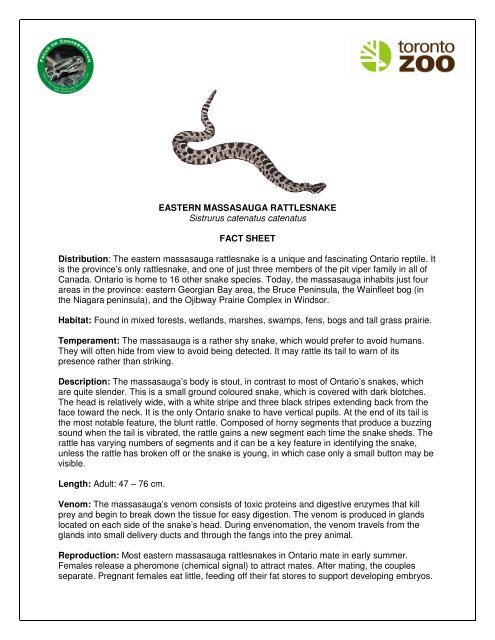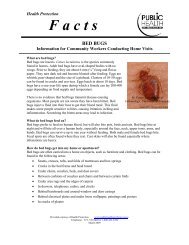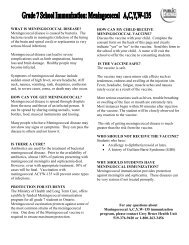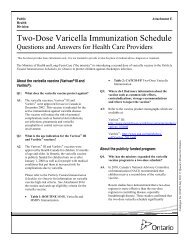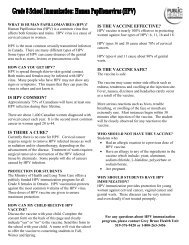Eastern Massasauga Rattlesnake - Fact Sheet - Grey Bruce Health ...
Eastern Massasauga Rattlesnake - Fact Sheet - Grey Bruce Health ...
Eastern Massasauga Rattlesnake - Fact Sheet - Grey Bruce Health ...
You also want an ePaper? Increase the reach of your titles
YUMPU automatically turns print PDFs into web optimized ePapers that Google loves.
EASTERN MASSASAUGA RATTLESNAKE<br />
Sistrurus catenatus catenatus<br />
FACT SHEET<br />
Distribution: The eastern massasauga rattlesnake is a unique and fascinating Ontario reptile. It<br />
is the province’s only rattlesnake, and one of just three members of the pit viper family in all of<br />
Canada. Ontario is home to 16 other snake species. Today, the massasauga inhabits just four<br />
areas in the province: eastern Georgian Bay area, the <strong>Bruce</strong> Peninsula, the Wainfleet bog (in<br />
the Niagara peninsula), and the Ojibway Prairie Complex in Windsor.<br />
Habitat: Found in mixed forests, wetlands, marshes, swamps, fens, bogs and tall grass prairie.<br />
Temperament: The massasauga is a rather shy snake, which would prefer to avoid humans.<br />
They will often hide from view to avoid being detected. It may rattle its tail to warn of its<br />
presence rather than striking.<br />
Description: The massasauga’s body is stout, in contrast to most of Ontario’s snakes, which<br />
are quite slender. This is a small ground coloured snake, which is covered with dark blotches.<br />
The head is relatively wide, with a white stripe and three black stripes extending back from the<br />
face toward the neck. It is the only Ontario snake to have vertical pupils. At the end of its tail is<br />
the most notable feature, the blunt rattle. Composed of horny segments that produce a buzzing<br />
sound when the tail is vibrated, the rattle gains a new segment each time the snake sheds. The<br />
rattle has varying numbers of segments and it can be a key feature in identifying the snake,<br />
unless the rattle has broken off or the snake is young, in which case only a small button may be<br />
visible.<br />
Length: Adult: 47 – 76 cm.<br />
Venom: The massasauga’s venom consists of toxic proteins and digestive enzymes that kill<br />
prey and begin to break down the tissue for easy digestion. The venom is produced in glands<br />
located on each side of the snake’s head. During envenomation, the venom travels from the<br />
glands into small delivery ducts and through the fangs into the prey animal.<br />
Reproduction: Most eastern massasauga rattlesnakes in Ontario mate in early summer.<br />
Females release a pheromone (chemical signal) to attract mates. After mating, the couples<br />
separate. Pregnant females eat little, feeding off their fat stores to support developing embryos.
Membranous (thin tissue) eggs are incubated internally and the young are delivered live<br />
following a gestation period of two to four months. Six to twenty young, approximately 20 cm<br />
long, are born.<br />
Life span: About 18 years in the wild.<br />
Wild Diet: Like most vipers, the <strong>Massasauga</strong> has a heat sensitive pit, which allows it to detect<br />
warm-blooded prey even in the dark. Eats small mammals such as mice, also small birds, other<br />
snakes and amphibians.<br />
Status: The federal Species at Risk Act, and the provincial Endangered Species Act have<br />
designated the eastern massasauga rattlesnake as a Threatened species. This designation<br />
legally protects the massasauga from being harassed, captured, killed, bought, or sold. A<br />
violation of either Act can result in a maximum fine of $250,000 and/or imprisonment for up to<br />
one year. A violation for commercial purposes increases the penalty to a maximum fine of<br />
$1,000,000.<br />
SNAKE SAFETY TIPS:<br />
1. Learn to identify Ontario snakes, and to distinguish the eastern massasauga rattlesnake<br />
from other snakes that resemble it. Children can also be taught to identify the massasauga;<br />
2. Wear protective footwear (such as hiking boots that cover the ankles) and long, loose fitting<br />
pants, especially when hiking in open rocky areas or places where vision may be obscured,<br />
such as in long grass or at night;<br />
3. DO NOT pick up snakes or other wild animals. This act is the most common cause of bites;<br />
4. Do not harass, chase or threaten a snake. This act is the second most common cause of<br />
bites. Most importantly, never kill a massasauga rattlesnake, which is unnecessary,<br />
dangerous, and illegal due to its protected status;<br />
5. Always watch where you are putting your feet and hands. Poke around with a stick before<br />
reaching into brush, under rocks, or into dark places where snakes may be hiding;<br />
6. If you hear a rattlesnake, STAY CALM! Stop walking, and then determine the snake’s<br />
location. Slowly move away from the snake and give it room to also move away;<br />
7. Keep pets on leashes; curious pets at large are more often the victims of snakebites than<br />
people.<br />
If you come across a snake, the best advice is to enjoy the unique encounter but observe it from<br />
a safe distance and try not to disturb the snake.


